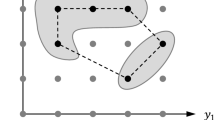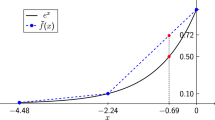In this article, we generalize Krasnoschekov’s scheme [6] to improve the solution of the max-min targetallocation problem by excluding some types of targets that are not entirely suited for the allocation of the available defense tools. The problem is not submodular, it is therefore solved by the general branchand- bound method using objective-function upper bounds. We show how to construct such bounds using Germeier’s generalized equalization principle. This development endows the branch-and-bound method with new practical significance.
Similar content being viewed by others
References
E. A. Berzin, Optimal Resource Allocation and Elements of System Synthesis [in Russian], Radio i Svyaz’, Moscow (1974).
E. A. Berzin, Optimal Resource Allocation and Game Theory [in Russian], Radio i Svyaz’, Moscow (1983).
S. Karlin, Mathematical Methods in Game Theoroy, Programming, and Economics [Russian translation], Mir, Moscow (1964).
A. A. Vasin, P. S. Krasnoschekov, and V. V. Morozov, Operations Research [in Russian], Akademiya, Moscow (2008).
Yu. B. Germeier, Introduction to Operations Research Theory [in Russian], Nauka, Moscow (1971).
P. S. Krasnoschekov and A. A. Petrov, The Model Construction Principle [in Russian], Fazis, Moscow (2000).
N. S. Volgin, Operations Research [in Russian], Izd. VMA im. N. G. Kuznetsova, Sankt-Peterburg (1999).
V. R. Khachaturov, Roman V. Khachaturov, and Ruben V. Khachaturov, “Optimization of supermodular functions (supermodular programming),” Zh. Vychisl. Mat. i Matem. Fiz., 52, No. 6, 999–1000 (2012).
V. Y. Reshetov, A. G. Perevozchikov, and I. A. Lesik, “A model of overpowering a multilevel defense system by attack,” Computational Mathematics and Modeling, 27, No. 2, 254–269 (2016).
V. Y. Reshetov, A. G. Perevozchikov, and I. A. Lesik, “Multi-level defense system models: Overcoming by means of attacks with several phase constraints,” Moscow University Computational Mathematics and Cybernetics, 1, No. 1, 25–31 (2017).
V. Y. Reshetov, A. G. Perevozchikov, and I. E. Yanochkin, “A discrete multilevel attack-defense model with nonhomogeneous opponent resources,” Computational Mathematics and Modeling, 29, No. 2, 134–145 (2018).
V. Y. Reshetov, A. G. Perevozchikov, and I. E. Yanochkin, “An attack-defense model with inhomogeneous resources of the opponents,” Computational Mathematics and Mathematical Physics, 58, No. 1, 38–47 (2018).
V. Y. Reshetov, A. G. Perevozchikov, and I. E. Yanochkin, “Multilayered attack-defense model on networks,” Computational Mathematics and Mathematical Physics, 59, No. 8, 1389–1397 (2019).
R. Hohzaki and V. Tanaka, “The effects of players recognition about the acquisition of his information by his opponent in an attrition game on a network,” in: Abstracts of 27th European Conf. on Operational Research 12–15 July 2015, University of Strathclyde – EURO2015.
A. G. Perevozchikov, V. Y. Reshetov, and I. E. Yanochkin, “Multi-step game of reserves management in the attack-defense model,” Science Journal of Applied Mathematics and Statistics, 7, No. 5, 63–70 (2019).
P. Y. Kabankov, A. G. Perevozchikov, V. Y. Reshetov, and I. E. Yanochkin, “Symmetrization of the classical “attack-defense” model, Science Journal of Applied Mathematics and Statistics, 8, No. 1, 1–10 (2020).
R. Hohzaki, “Effects of a player’s awareness of information acquisition and ability to change strategy in attrition games,” Journal of the Operational Research Society of Japan, 60, No. 3, 353–378 (2017).
R. Hohzaki, E. Fukuda, K. Sakai, and Y. Sakuma, “Risk evaluation and games in mine warfare considering ship counter effects,” European Journal of Operational Research, 268, No. 1, 300–313 (2018).
R. Hohzaki and A. R. Washburn, “An approximation for a continuous datum search game with energy constraint,” Journal of the Operational Research Society of Japan, 46, No. 3, 306–318 (2003).
A. A. Vasin and V. V. Morozov, Game Theory and Mathematical Economic Models [in Russian], MAKS Press, Moscow (2005).
V. V. Fedorov, Numerical Max-Min Methods [in Russian], Nauka, Moscow (1979).
D. A. Molodtsov, “Equalization principle in one resource allocation problem with cooperative interests,” Zh. Vychisl. Mat. i Matem. Fiz., 13, No. 2, 318–325 (1973).
B. T. Polyak, Introduction to Optimization [in Russian], Nauka, Moscow (1983).
V. S. Mikhalevich, A. M. Gupal, and V. I. Norkin, Nonconvex Optimization Methods [in Russian], Nauka, Moscow (1987).
A. G. Sukharev, A. V. Timokhov, and V. V. Fedorov, A Course of Optimization Methods [in Russian], Nauka, Moscow (1986).
Author information
Authors and Affiliations
Corresponding author
Additional information
Translated from Prikladnaya Matematika i Informatika, No. 66, 2021, pp. 89–103.
Rights and permissions
About this article
Cite this article
Perevozchikov, A.G., Reshetov, V.Y. & Yanochkin, I.E. Generalized Target-Allocation Functions and their Evaluation by the Branch-And-Bound Method. Comput Math Model 32, 183–197 (2021). https://doi.org/10.1007/s10598-021-09525-y
Published:
Issue Date:
DOI: https://doi.org/10.1007/s10598-021-09525-y




